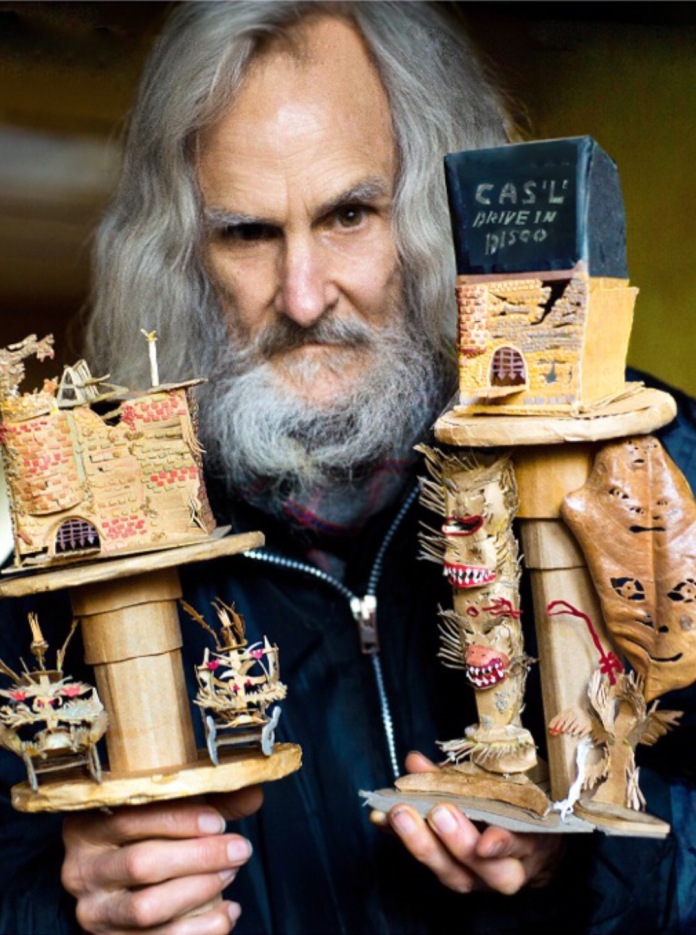Bruce Bickford at Seattle’s Flatcolor Gallery at 77 S. Main St. Near Seattle’s Pioneer Square.
A small exhibition of maybe about 50 works, depending on how you choose to count them in this neat little gallery. The pieces are multimedia, including clay models, colour pencil drawing, models made of card and faces cut into dried leaves by this most idiosyncratic artist. All objects highly detailed, intricate and phantasmagorical, some funny, some disturbing. The show is titled ‘Sacred and Profane’ for no obvious reason. Bickford’s video The CAS’L’ is projected on a wall.
I approached the show as a Zappa fan so that’s the main theme of this review. The show is good but it was disappointing to find only one mention of Zappa. This was on a highly intricate clay piece with Bickford ‘s hand written label saying:
‘In 1974 Frank Zappa wanted an audience for a scene of Camp Reagan, a takeoff on the Franz Kafka story… “In The Penal Colony”. It never got animated‘

The sleeve notes on ‘We’re Only In It For The Money‘ refer to this story about the track: ‘The Chrome Plated Megaphone Of Destiny’. The piece, (photo 1) represents a crowd on 16 levels of seating, with 16 seats on each row. The figures occupying the seats are naked, mostly male, some female, they look towards the action. In Kafka’s story, the action is: the Officer, proudly demonstrating the machine to the Traveller falls into the machine and suffers the torture himself intended for the Condemned Man . The victim is intended to find out what his crime is by having it repeatedly inscribed, deeper and deeper on his body by needles; so The Torture, for him, Never Stops; Bickford’s crowd sit riveted.
As far as I could see,that’s about as far as it goes for the Zappaologist visiting to the exhibition, but the artwork is stunning. The detail and surety of line are truly impressive. They have depth and precision using graphite and colour pencil applied to paper or brown paper bags each carrying the same feeling of obsessional attention to detail and using surfaces and materials that come to hand.
I was told by the gallery staff that Bickford occasionally dropped by but I wasn’t lucky enough to meet him. I would have liked a conversation about his association with Zappa.
Thinking of other guitarist to artist relationships – Zappa to Cal Schenkel; Bill Frisell to Jim Woodring; Robert Fripp to PJ Crook; Lou Reed to Warhol…err…Pink Floyd to Gerald Scarfe…it seems to me that Zappa is the only musician who was really ‘hands-on’ or with the artist appearing to get into the ideas of the musician. Zappa’s themes of taking down a facade to show the machinery behind it and self-reference are both evident in Schenkel and Bickford.












A fascinating review of an exhibition that very few members of the International Zappa community will have the chance to visit. A big vote of thanks to IFOTHERGILLS for providing us with such well chosen words and pictures. You provoke much food for thought with your examples of Guitarist/Artist partnerships.
I wonder if Bruce Bickford fits neatly with the the artists you mention or if he could more accurately be described as an “Outsider Artist.” Discuss. Use both sides of the paper. You have 3 hours. Start Now.
Anyway….. I’m very glad that you gave us such a wide-ranging review of this idiosyncratic exhibition.
LikeLike
Thanks for that, Ian. All that stop-motion must need quite an obsessional character trait. I think you are right about there being no other guitarist seeking that level of background revelation. I was first reminded of ‘Cheap Thrills’ and Robert Crumb, but that is simply illustrative, and there is also Urs Amman and Klaus Schulze, again illustrative. Arguably Pink Floyd’s relationship with Hypgnosis (Storm Thorgerson) gets closer, and there is some animation in one of their pieces. But the point here is the exposure of background, which is of course in so many Zappa/Mothers songs. Perhaps this is more like the revelation at the end of The Wizard of Oz, a film which terrified me as a child.
I suppose that this ‘will to reveal’ the background is consistent with modernist/post-modernist approaches, like perhaps Penn&Teller showing how it’s done, or better Nina Conti’s extraordinary ability to be a ventriloquist with nothing there…
We were at Stratford last week to see Don Quixote, which I confess to never having read. I now see why it is so important, as I now understand that the second part of the book follows his exploits after having read about his own earlier ones. Not quite meta-fiction, but perilously close. And which could bring us back to Kafka…
Cheers
John
LikeLike